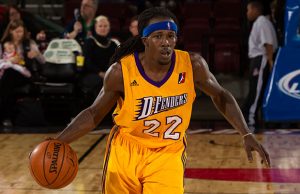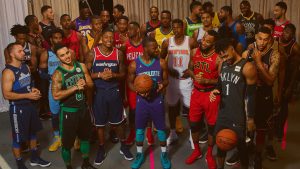Welcome to Four Down Territory! This is a space where I’ll write about four things in professional sports every Saturday. Whether it’s the four greatest moments or the four worst blunders or anything in between, the only rule is that I’ll discuss four things. In my twelfth installment, I’ll be continuing my previous article on some of the best forgotten players to play in the NBA.
We always remember the stars that shone brightest: those who made the most explosive plays, performed at a consistently high level, or won the most championships. But what about those players who weren’t quite at that level? Or those players who really were that great but never won championships or made astounding plays? Yes, these are among some of the players that get forgotten throughout history, but rest assured I still remember them. I’ve split this into two parts so that I can cover each decade in the NBA, and today we’ll begin in the 1980s. Hope you enjoy!
1980s: Sidney Moncrief (Milwaukee Bucks, Atlanta Hawks)
When we think of the 1980s, we think of four dominant teams and one rising challenger. Los Angeles, Boston, Detroit, and Philadelphia were on top for the entire decade, and Chicago’s power was growing every day with a young Michael Jordan. Lost in the shuffle was the Milwaukee Bucks, a perennial 60-win team that just didn’t have the talent to match up with the best teams of the decade. They won the division for seven consecutive seasons while playing basketball the right way: distributing the ball, having many players average double figures, and playing tough defense. The unquestioned leader of this group was Sidney Moncrief. Back in that time, Moncrief was known for his particularly tenacious defense, as he is the only guard in NBA history to be named NBA Defensive Player of the Year twice. Michael Jordan considered Moncrief a worthy opponent who hounded him all around the court defensively, and he was no slouch on the offensive end either. For all but one season, Moncrief averaged double figures, and he had 20 points per game or better for four consecutive seasons. Unfortunately, he gets lost in NBA history, playing for a small-market team that were a tier below the NBA’s best but still very good. Noticing a pattern for these forgotten players?
1990s: Drazen Petrovic (Portland Trail Blazers, New Jersey Nets)
This article was really just another excuse for me to write about Drazen Petrovic. When we think of the greatest European players in NBA history, names like Dirk Nowitzki and Tony Parker immediately come to mind, and rightfully so. But Petrovic was the first, and in my mind, the best. Petrovic was an important part of the vanguard from Europe, along with Vlade Divac, Toni Kukoc, and Dino Radja. What separates Petrovic from these players is that he’s a pure guard, and he shattered the perception that European guards were not athletic enough to play in the NBA. Of course, nobody is mistaking Petrovic for a lockdown defender. But, there’s a reason he’s called the Mozart of Basketball: he is extremely creative on the court. Whether it’s creating shots for himself or opening the floor to his teammates, Petrovic made basketball an art form, and it’s tragic that the NBA only got to see two seasons of what Drazen could be with the Nets. The numbers are staggering: 21.4 points per game shooting 44.6% from three, with an effective field goal percentage of 55.3% and a true shooting percentage of 59.5%. Unfortunately, he died in a brutal car accident following the Nets 1992-93 season, and as a result, people never mention him among the great shooters and players of all time. For those two seasons, Drazen shone like a shooting star, and it’s a shame that we forget his great accomplishments in paving the way for the NBA to be a truly global sport.
2000s: Ben Gordon (Chicago Bulls, Detroit Pistons, Charlotte Bobcats, Orlando Magic)
When we think of the Chicago Bulls, two eras come to mind. First is obviously the Jordan era, where he exploded onto the scene in the 1980s and the team was brilliant in the 1990s. Second is the Derrick Rose/Tom Thibodeau era Bulls, a tough, gritty team built around the youngest MVP ever and a relentless defensive team. But what about the era in the middle? It started off poorly: Chicago floundered to a 13-37 record in the shortened 1998-99 season, and they wouldn’t have another winning season until 2004. These teams were positively awful, and they made poor front-office decisions too, trading future All-Star Elton Brand and drafting two big men out of high school in the same year (Tyson Chandler and Eddy Curry). Their fortunes changed in 2004, with the arrival of Ben Gordon. Gordon was a sniper for the University of Connecticut, and that’s what defined his NBA career as well. During his time in Chicago, Gordon established himself as a great scorer, averaging 18.5 points per game and shooting 41.5% from three, with a true shooting percentage of 55.4%. But what’s most important is that Gordon, along with fellow 2004 draft pick Luol Deng, brought the Bulls back to respectability and competitiveness. His finest effort was in the 2009 playoffs against the mighty Boston Celtics. Gordon carried the Bulls with 24.3 points per game in the series, pushing the defending champions to seven games before bowing out. Betting on himself, he signed a lucrative deal with Detroit, but the Pistons were rebuilding and Gordon did not get enough opportunities. We forget Ben Gordon because of the team success that the Bulls had before and after he was there. I still believe that Gordon walked so Derrick Rose could fly.
2010s: Mike Conley (Memphis Grizzlies, Utah Jazz)
This is the era of the superteam and of social media. The best and brightest stars want to play with each other to ensure their best chance at a championship, and social media has fans engaging with players like never before. But even in this age of information and interaction, there are still players that slip through the cracks because they’re not necessarily the best and brightest stars, and they keep a low profile in a small-market city. Mike Conley checks all these boxes. Fairly or unfairly, he’s never made an All-Star team, despite being a consistently above-average point guard for a perennial playoff team. Conley is actually quite similar to Sidney Moncrief as an NBA player. Though Moncrief was one of the great defensive guards, Conley more than held his own as an important member of the Grit ‘n Grind Grizzlies, and his offensive game was also quite good. In his best season (2016-17), he averaged 20.5 points per game on 40.8% from three to go along with 6.3 assists per game. But again, Conley suffered from all the forgotten player tropes: small market team that never won a championship, great but not elite player, and a quieter guy who never pounded his chest about this game. Hopefully he can experience that success with the Jazz in a more balanced Western Conference, because he should be remembered as a great facilitator and hardworking player. Isn’t that what you would want out of a point guard?






[…] Four Down Territory – Forgotten NBA Stars (Part 2) The Georgetown Voice […]